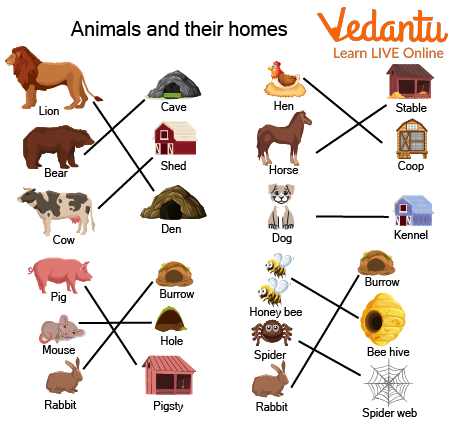How Do Animals Choose and Adapt to Their Habitats?
The concept of animal habitats is essential in biology and helps explain real-world biological processes and exam-level questions effectively.
Understanding Animal Habitats
Animal habitats refer to the natural places where animals live, grow, and reproduce. A habitat provides food, water, shelter, and space for survival. This concept is important in areas like adaptation, biodiversity, and ecosystem studies.

Types of Animal Habitats
Animal habitats can be categorized based on location and environment:
- Forest habitats
- Grassland habitats
- Desert habitats
- Mountain habitats
- Wetland habitats
- Freshwater habitats (rivers, lakes, ponds)
- Marine (ocean) habitats
- Polar habitats (Arctic, Antarctic)
Each habitat type supports unique plants and animals adapted to those conditions.
Examples of Animal Habitats
Here’s a helpful table to understand animal habitats better:
10 Animals and Their Habitats
| Animal | Habitat | Adaptation/Example |
|---|---|---|
| Lion | Grassland (Savanna) | Camouflaged fur, hunting in groups |
| Camel | Desert | Humps store fat; long eyelashes |
| Polar Bear | Polar Region (Arctic) | Thick fur, fat layer for warmth |
| Frog | Freshwater (Pond, Lake) | Moist skin for breathing |
| Shark | Ocean (Marine) | Streamlined body, gills for breathing |
| Giraffe | Grassland | Long neck to reach tall trees |
| Elephant | Forest/Grassland | Large ears for heat regulation |
| Penguin | Polar Region (Antarctica) | Flippers for swimming, dense feathers |
| Deer | Forest | Strong legs for running from predators |
| Crocodile | River (Freshwater) | Eyes and nostrils on top of head |
How Animals Adapt to Their Habitats
Animals develop special features, called adaptations, to survive in their habitats. For example, desert animals conserve water, forest animals may camouflage, and polar animals have thick fur or blubber. See more about this on our Adaptation and Habitats page.

Worksheets and Activity Ideas
- Download worksheets on animal habitats from Vedantu for revision.
- Try making dioramas or simple art projects about forest or ocean habitats.
- Observe local parks or water bodies and note the animals seen.
You can enhance your learning with interactive activities and by visiting the Grassland Adaptations or Terrestrial Habitat resources.
Habitats Near You – Discovering Animal Habitats
Explore your neighborhood for places like gardens, ponds, or open fields. Observe which animals you find and how their bodies help them live there. This real-world research can make your biology project stand out!
- Look for ants under stones (microhabitats).
- Spot birds in trees or water bodies.
- Notice insects near lights or plants at night.
Common Mistakes to Avoid
- Confusing animal habitat with environment (habitat = animal’s home, environment = all surroundings).
- Forgetting that some animals can live in more than one habitat.
- Assuming all animals need the same kind of shelter or food.
Real-World Applications
The concept of animal habitats is used in environmental protection, wildlife conservation, and understanding climate change effects on living organisms. Vedantu helps students connect these ideas to their daily lives and future careers in science, agriculture, and ecosystem management.
Page Summary
In this article, we explored animal habitats, their types, animal adaptations, key questions, and practical examples for students. To deepen your understanding, visit other Vedantu resources and practice with activity sheets and quizzes.
Further Reading – Internal Links
- Adaptation and Habitats
- Terrestrial Habitat
- Forests - Our Lifeline
- Biodiversity in Plants and Animals
- Desertification
- National Parks and Sanctuaries
- Herbivores and Carnivores
- Our Environment
- Grassland Adaptations
- Ecosystem Services
- Living Organisms: Characteristics and Habitats


FAQs on Animal Habitats Simplified: Types, Examples & Adaptations
1. What is an animal habitat?
An animal habitat is the natural environment where an animal lives, grows, and thrives. It provides essential needs like food, shelter, and protection. Habitats can vary widely, including forests, deserts, oceans, and grasslands, each supporting different types of animals.
2. What are the five habitats of animals?
The five major animal habitats commonly referred to in school syllabi are:
1. Forest
2. Grassland
3. Desert
4. Arctic (Cold regions)
5. Ocean (Aquatic habitat)
Each habitat offers unique biotic and abiotic factors influencing the animals living there.
3. What are the 8 animal habitats?
The broad classification of animal habitats can include these eight types:
1. Temperate forests
2. Tropical forests
3. Boreal forests
4. Grasslands (tropical and temperate)
5. Deserts (hot, cold, coastal, semi-arid)
6. Wetlands (marshes, swamps, peat bogs)
7. Freshwater habitats (rivers, lakes, ponds)
8. Marine habitats (pelagic and demersal zones)
This classification helps students understand the diversity and adaptations of animals.
4. Can you give examples of animals and their habitats?
Yes, here are some examples linking animals to their natural habitats:
- White-tailed deer in temperate forests
- Mountain gorillas in tropical forests
- Fennec foxes in hot deserts
- Giraffes in tropical grasslands
- Otters in freshwater rivers
- Sea turtles in marine pelagic zones
These examples help students with projects and worksheets.
5. Why do animals need different habitats?
Animals need different habitats because each habitat provides specific conditions essential for their survival, growth, and reproduction. Factors like climate, temperature, food availability, shelter, and protection from predators vary across habitats, requiring animals to adapt uniquely to each environment.
6. How can I make an animal habitats project?
To make a successful animal habitats project, follow these steps:
1. Choose 3–5 different habitats to focus on.
2. Research common animals and their adaptations in each habitat.
3. Include pictures or drawings of habitats and animals.
4. Add a table linking animals to their specific habitats.
5. Use simple language and highlight key terms like ecosystem, biotic, and abiotic factors.
This approach helps explain the topic clearly for classmates and teachers.
7. What is a microhabitat?
A microhabitat is a small, specific area within a larger habitat that has unique conditions differing from its surroundings. Examples include the underside of a rock, a decomposing log, or a temporary water pool. Microhabitats often support specialized plants and animals not found elsewhere in the larger habitat.
8. How do animals survive in different habitats?
Animals survive in different habitats through various adaptations such as:
- Physical features like fur, feathers, scales, or body shape to suit climate.
- Behavioural changes like migration or nocturnal activity.
- Specialized methods of obtaining food or water.
These adaptations help them thrive and compete in their natural environments.
9. How do terrestrial and aquatic animals differ in breathing?
Terrestrial animals breathe using lungs to take in molecular oxygen from the air. In contrast, aquatic animals breathe through gills which extract dissolved oxygen from water. This difference matches adaptations related to their respective habitats and lifestyles.
10. What is the difference between a habitat and a niche?
A habitat is the physical place where an animal or plant lives, while a niche describes the role or function that organism has within its habitat or ecosystem. The niche includes its interactions with other organisms, food sources, and behavior, making it a conceptual rather than spatial term.
11. Why do students often confuse 'habitat' with 'ecosystem'?
Students sometimes confuse habitat with ecosystem because both involve living organisms and their environment. However, a habitat focuses on the specific place an organism lives, whereas an ecosystem includes all living organisms interacting with each other and with abiotic components within a larger area.
12. How do climate change and pollution affect animal habitats?
Climate change and pollution negatively impact animal habitats by:
- Altering temperature and rainfall patterns affecting food and shelter availability.
- Causing habitat destruction like deforestation and coral bleaching.
- Introducing harmful substances that disrupt the health of species.
Understanding these effects helps students appreciate conservation efforts.










